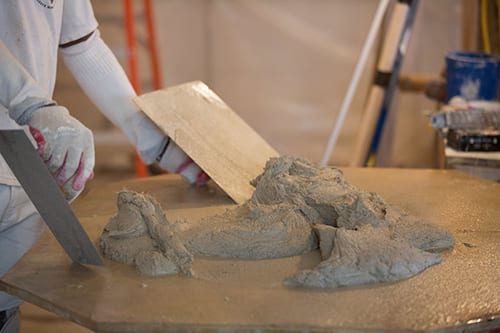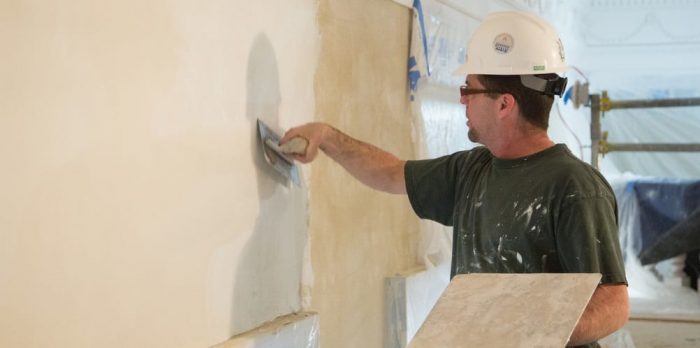Common Plaster Defects from Workmanship and How to Diagnose Them

Many common flaws visible in the surface plaster often result from poor workmanship across multiple plaster layers. Plaster application is built up in three layers, from the inner layer out: scratch, brown, and white. Three-layer plaster applications in historic settings offer certain advantages to the building including offering some fire retarding properties, can be sound-dampening, and has unparalleled strength and durability. Here are some common workmanship plaster defects and tips on how to diagnose and remedy them.
Improper Plaster Mixture
As previously mentioned, historic plaster is built up in three layers, each with its own unique combination of base elements. Crumbling plaster on the white layer is the result of one or more layers have an incorrect, or poorly suited mixture. Commonly, plaster that crumbles into a fine dust when an object meets the surface is the result of too little cementing material. In historic buildings, cementing materials are commonly lime or gypsum, mixed with fine sand and animal fibers. Adding too little lime or gypsum prevents the sand from binding together.
Diagnosis:
Improper plaster mixture is relatively easy to diagnose. If the plaster disintegrates on contact into a fine sand, then an inadequate amount of cementing compound is most likely the root cause.
Remedy:
The remedy would depend on the scope of the crumbling area. As plaster needs to remain wet when applied to the surface, it is not uncommon for a room to be done in sections. If only one section is damaged, then it should be fully removed down to the lath. If the scratch and brown plaster applications appear to be in good shape and remain undamaged from the removal of the top layer, then a new white layer can be applied over it. If an entire room of plaster needs to be removed, all three layers are of poor mix quality, or a variation thereof, then a decision should be made about fully restoring the area with a three-layer plaster approach or using more current methods to save money.


Improper Base Coat
Having a good foundation is the key to any successful project. A plaster base coat should be an appropriate match for the surface it is being applied to. Four common under layers are brick, stone, metal, and wood. Each material has different characteristic and will interact with plaster in different ways. Moreover, each of these materials transfers heat and stores moisture differently. It is important to use the right material components and in the correct proportions to ensure that there will not be any detrimental interactions between the surface and the scratch layer. In addition to making sure that the primary layer and under surface is properly matched, it is imperative that the base layer be a clean, even coat of plaster. An uneven surface will cause uneven drying and result in cracks. This will become a complex problem if subsequent layers are added on top of plaster that is not fully dried. The additional layers slow the rate that under layers dries at. When they finally dry and settle, it will be too late—deep cracks down to the base layer will appear in the plaster.
Diagnosis:
An improper base coat will result in cracks forming in the plaster that extend through all three layers of plaster. Additionally, it might cause top layers to break off if it was applied to a surface that was not fully dried.
Remedy:
All three layers of plaster will have to be removed to the undersurface. To reiterate, building up plaster layers is a complex task, especially if the base layer is not smooth, is porous, or expands and contracts with temperature/moisture. To prevent a repeat occurrence, it is important to consult an experienced plasterer.


Improper Plaster Thickness
As previously touched upon, an uneven application of the basecoat can result in problems across all subsequent layers; the same holds true for any layer of plaster. There are ramifications for unevenly applied brown and white plaster layers, too. Often cracks will appear that, over time, will enlarge and extend across multiple layers of the plaster. It should be noted that the thickness of each layer is dependent on the base material the plaster is being applied to brick, stone, wood, metal. Each of these base materials has a standard layering method that should be adhered to, though climate may change this. Lastly, an inadequate number of layers, or too many layers can cause noticeable surface abnormalities.
Diagnosis:
Depending on the number of layers that did not cure properly, it is common to expect that chipping and cracking can occur and will result in multiple layers of plaster coming off. Chipping to the white layer will coming result in some of the brown layer also chipping off with it.
Remedy:
The plaster will have to be removed. In some cases, the problematic player will chip off with minimal impact on the previous layers, though this typically occurs when there are multiple errors in the plaster application process.
Three-layer plaster application is a beautiful touch worth restoring in a historic space, but it is important that it be done right and a professional is consulted. Each layer has special characteristics and specifications that must be met in order to ensure the finished product will endure.
When it comes time to repairing or replace historic plaster, it is important to seek the help of knowledgeable professionals, as it can be difficult for a layman to identify the type of plaster, composition, and appropriate layering needed to match the existing surface. Check to make sure your restoration contractor has a complete understanding of historic plaster conservation and restoration. Restoring layered plaster applications on any substrate is both time consuming and expensive, so it is imperative that any repairs be done by a professional, to avoid compounding existing poor workmanship.
